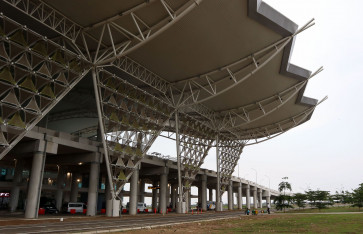Popular Reads
Top Results
Can't find what you're looking for?
View all search resultsPopular Reads
Top Results
Can't find what you're looking for?
View all search results‘Sekala Niskala’ Dance transforms grief into expression of life
Chicken or egg?: Twins Tantri (left) and Tantra perform in chicken costumes
Change text size
Gift Premium Articles
to Anyone
C
hicken or egg?: Twins Tantri (left) and Tantra perform in chicken costumes. According to choreographer Ida Ayu Wayan Arya Satyani, the Sekala Niskala dance stays true to the film, which uses chickens and eggs as metaphors for the continuation of the life cycle.
A dance adaptation of Kamila Andini’s critically acclaimed film Sekala Niskala (The Seen and Unseen) helps people contemplate how joy and sadness are deeply intertwined with one another.
Without having experienced deep sadness, can people truly appreciate the meaning of joy? Does the death of a loved one mark the end of the mutual love we share, or is it merely marking the transition into a more transcendental connection?
These questions, which make the central premise of Sekala Niskala (The Seen and Unseen), are brought to the fore in its recent dance-drama adaptation. The movie, directed by Kamila Andini, won the Grand Prix of the Generation KPlus International Jury at the Berlinale film festival last year.
Staged for the first time at the Komunitas Salihara cultural center in South Jakarta on June 15 and 16, the Sekala Niskala dance involves a cross-cultural troupe from Indonesia, Japan and Australia. The performance was part of the cultural center’s annual international dance festival called Helatari Salihara.
The dance, choreographed by Ida Ayu Wayan Arya Satyani, features dancers from the Bumi Bajra community from Bali. With Kamila serving as artistic director, the dance remains faithful to the film’s take on the issue of life-and-death as well as grieving to explore the Balinese sekala niskala concept of the harmonious balance of contrasting elements in life.
The dance also features Japan’s Yasuhiro Morinaga and three Australian artists: Eugyeene Teh, Jenny Hector and Adena Jacobs.
The story revolves around Tantri (played by 14-year-old Ni Kadek Thaly Titi Kasih) and Tantra (played by 15-year-old Ida Bagus Putu Radithya Mahijasena), unisex twins who were born when the moon was in full eclipse. Balinese people refer to unisex twins like them as kembar buncing. The twins joyfully play together under the protection of their four nonphysical siblings from the unseen realm.
Final days: Tantra spends time in a hospital ward as his life energy gradually declines.Their happy days come to an end when the brother Tantra falls ill and eventually dies. Tantri and her mother (played by musician and actress Ayu Laksmi) are devastated by the loss.
As days go by, Tantri is increasingly able to reconnect with her deceased brother, who has transitioned into the afterlife. She can sense the presence of her late brother’s spirit along with the four nonphysical siblings — all of whom work together and move Tantri’s body into a passionate dance.
The concept of sekala niskala is well applied through the dramaturgy, showcasing the balance of these polar opposites well.
The affection that the twins share turns into Tantri’s deep grief when her brother passes away. Through Tantri’s passionate movements, it seems that she has regained a better appreciation of life thanks to her late brother’s legacy and because she has processed her grief.
In the performance, the child actors and dancers performed their parts well in portraying difficult emotions such as grieving and the quiet resignation of succumbing to a terminal illness. Ni Kadek’s portrayal of grief in the performance was superb, as was her show of ecstasy when she was “possessed” in dancing by her twin brother’s spirit.
Choreographer Ida Ayu Wayan Arya Satyani said she guided the young dancers to incorporate difficult emotions such as grief by telling these teenage performers stories to motivate their movements and facial expressions.
For instance, when a particular dancer has to tilt their head toward a certain direction, she had to guide the dancer through questions such as, “Do you understand the circumstances that make you gaze toward that particular direction?”
Visually, the show is mesmerizing. Its minimum lighting and sometimes even total darkness helped the audience to connect intimately with the characters.
Kamila explained that the show sought to use death as a starting point to reconcile the opposing elements of sadness and joy; life and death; and kindness and violence.
“I believe we need to embrace life as it comes, to attain harmony among these elements, which are inevitable parts of life,” she explained.
Transcendence: Tantri (right) starts to sense the presence of her late brother’s spirit who, along with their non-physical siblings from the unseen world, animates her body into a passionate dance.— Photos by Komunitas Salihara/Witjak Widhi Cahya
___________
Sekala Niskala will be performed at Singapore’s Esplanade Theater Studio on June 28-29.












